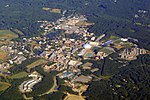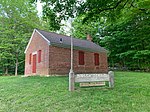Daniel Benton Homestead
Buildings and structures in Tolland County, ConnecticutHistoric house museums in ConnecticutHistory museums in ConnecticutMuseums in Tolland County, ConnecticutReportedly haunted locations in Connecticut ... and 1 more
Tolland, Connecticut

The Daniel Benton Homestead is a historic house museum and the oldest house in Tolland, Connecticut. It was built in 1720 and has been operated by the Tolland Historical Society as a museum since 1970.Along with the Old Tolland County Jail and Museum, the Tolland County Courthouse, and the Hicks-Stearns Family Museum, the Benton Homestead is one of Tolland's four major historic landmarks.
Excerpt from the Wikipedia article Daniel Benton Homestead (License: CC BY-SA 3.0, Authors, Images).Daniel Benton Homestead
Metcalf Road,
Geographical coordinates (GPS) Address Nearby Places Show on map
Geographical coordinates (GPS)
| Latitude | Longitude |
|---|---|
| N 41.851863 ° | E -72.377076 ° |
Address
Metcalf Road 154
06084
Connecticut, United States
Open on Google Maps











